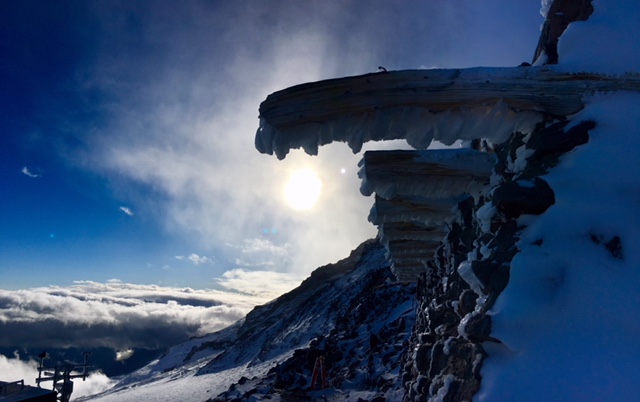Labor Day weekend brought pleasant weather and many day hikers to Camp Muir. Unfortunately, the upper mountain has not been quite as mellow or secure for climbers trying to reach the top. Firm conditions,
penitentes, and sun cups have combined to make travel on the upper mountain arduous at times. In addition to tricky snow conditions, large crevasse crossings, bridged by long ladders have been intimiating for both climbers and guides alike.
 |
| New route shown in blue. The old route (with ladders) is shown in maroon. Guides will remove the ladders on the old route in the coming days. |
It was time for a change, so guides ventured from the top of the Disappointment Cleaver towards Camp Comfort, determined to find a better route. The new route avoids the large ladders above Dissapointment Cleaver, but one ladder still exists above Ingraham Flats.
 |
| The ladder at 'High Crack' above Ingraham Flats at 11,400 feet. |
Near the top of Disappointment Cleaver at about 12,200 feet, the route traverses climber’s left across the Ingraham glacier under an icefall zone. Move quickly through this area, as the icefall has remained active in recent weeks. At 12,400 feet, the route begins switchbacking up to Camp Comfort.
 |
| Icefall hazard still exists on the Ingraham glacier while traversing towards Camp Comfort. (Photo: Pete Van Deventer) |
From Camp Comfort, the route traverses west, gaining elevation slowly until 13,200 feet, where a fin is negotiated by squeezing through seracs in the glacier above the Nisqually Cleaver. After the squeeze section, the route heads straight up until it meets the old boot pack at 13,700 feet. Between 13,200 and 13,700 feet, there are places where the path is narrow and a bit exposed. The path to the crater rim from 13,700 feet is unchanged.
 |
| Climbers taking a break on the traverse above Camp Comfort with Gibraltar Rock below. (Photo: Pete Van Deventer) |
The new route is a little more direct than the old route, however, be prepared for a long summit day non the less. Several parties have underestimated the slow and difficult travel on the upper mountain this week, and have reached Camp Muir quite late in the day. September climbing on Mt. Rainier necessitates efficient movement, good time management, and the mental fortitude for a long day of climbing.
Favorable climbing weather is projected through Thursday. Another weather system approaches the mountain Thursday night, and stormy weather is likely this weekend. Monitor the
Mount Rainier Recreational Forecast closely if you plan on climbing this weekend.
 It's best to wait out poor conditions and likely injury to shred real pow in the heart of winter. Going for a trail run, foraging for huckleberries, and maybe even a late-season swim in an alpine lake with a thin wet suit are all more seasonally appropriate activities.
It's best to wait out poor conditions and likely injury to shred real pow in the heart of winter. Going for a trail run, foraging for huckleberries, and maybe even a late-season swim in an alpine lake with a thin wet suit are all more seasonally appropriate activities. 




















































